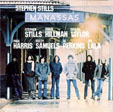
Manassas (1972)By 1972, following the ill-fated tour to support Stephen Stills 2, the artist seemed to have put his demons to rest. He'd been heralded as one the greatest guitar players of his generation, he'd created music with some of the best songwriters in the music business, and he'd jammed with Clapton, Hendrix, and Neil Young. But he'd also been slammed by music critics who felt the output of his solo years never measured up to his career-defining achievements with Buffalo Springfield or Crobsy, Stills & Nash (and sometimes Young). Weary of trying to placate the record companies and the music pundits, Stills turned his attention to a new musical direction with a new band, and in so doing, produced the best work of his entire career. By this time, Stills no doubt had learned that his most vital work was collaborative and s Manassas, as the band was christened, became a meat and potatoes rock and roll band that could play anything--rock, country, folk, bluegrass--and play it well. Gone were the horns and orchestrations, and Stills' propensity for showboating. Stills and Manassas produced a brilliant double album that comprised four concepts or themes, one for each side of the LP. With twenty-two cuts and literally no filler, Manassas deservedly reach # 4 on Billboard's Album chart, even without much support from Atlantic Records. Here's a rundown of each concept from this landmark record. The Raven. If you had the good fortune to see Manassas tour, you'd have heard them play this first side of record one, an uninterrupted medley of six songs. The opener, Song of Love, is ballsy rock and roll marked by Stills' powerful vocal and Al Perkins' screaming slide guitar. This segue effortlessly into Rock & Roll Crazies, Stills and Dallas Taylor's ode to the shallow life of a rock and roll star. Stills sings from experience:
From this, Manassas turns on a dime and delivers Stills' and Lala's Cuban Bluegrass, with its infectious, syncopated Latin piano riff played in octaves. Throughout his career, Stills would serve as one of the harbingers of Latin rock (beginning with Springfield's Uno Mundo and the Spanish vamp at the end of Judy Blue Eyes). The medley moves through two more songs, with extended jams, then slides into one of the prettiest ballads in Stills' repertoire. Co-written with Hillman, Both of Us (Bound to Lose) has the ex-Byrd member and Stills each singing a verse then harmonizing the final verse in a brilliant arrangement framed with ringing acoustic guitars, tremolo electric piano, and a sweet guitar solo. Hillman's voice is relaxed and emotive, complimenting Stills' gravelly bluesman vocals. The Wilderness. Or Grand Ole Opry--Manassas-style. Fallen Eagle kicks off side two with a wild bluegrass tune, driven by country fiddle and Hillman's fiery mandolin playing. The humorous lyrics decry the eagle's pending extinction at the hands of greedy ranchers. At the real Opry, this would have raised some eyebrows, but the tune is executed with that same kind of energy and crisp playing we hear from Nashville cats like Ricky Scaggs. Al Perkins' lightning-fast pedal steel guitar solo is a standout. Happily, Stills reaches into his bag of older songs and finally entrusts So Begins the Task to Manassas in what is one of many highlights of the album. Musing once again about Judy Collins, Stills sings with the heart of a poet, offering lines such as:
The vocal blend on the chorus of this song is the best this side of CSN's first record. Side two ends with Stills' humble response to his critics. Also filled with great melodic hooks, Don't Look at My Shadow is Stills' looking forward, no longer leaning on his fame or the hype surrounding it. Consider. Side three of this debut album is so strong you realize Stills is riding a wave of creativity unmatched by any time in his career. Consider kicks off with It Doesn't Matter, a stellar collaboration between Stills and Hillman containing one of Stills' catchiest guitar hooks ever. In sweet melody and harmony, the two vocalists sing out:
Taylor, Lala, and Samuels lay out a driving rhythm, embellished by Perkins' pedal steel and Harris' organ pumped through a Leslie rotary speaker. When Stills launches into the guitar solo, he seems completely at ease, focusing on "feel" rather than technique, saying all he needs to say with fewer notes. If there is one song on this double album that epitomizes the talent of this band, it has to be It Doesn't Matter. Johnny's Garden is another gem from Consider. From the evocative verses, we imagine Stills sitting in the garden of the house be bought from Ringo Starr while living in England, enjoying a quiet respite from life on the road. He sings of his gardener's handiwork:
Side three also contains a dazzling cover of a Michael Brewer (of Brewer and Shipley) and Tom Mastin song, called Bound to Fall. Stills plays an alternate tuned acoustic guitar with precision and fury, reminding us of the fire of Bluebird and Judy Blue Eyes. The Love Gangster is a smoking R&B song with Stills' wah-wah guitar hooks and Bill Wyman sitting in on bass. Rock & Roll is Here To Stay. Amen to that. Still one more great album side devoted to rock, revealing everything Stills has learned about song craft, arranging, vocal color, and guitar style. What to Do is a wonderful amalgamation of honkey-tonk Southern style and thundering guitar hooks. Stills' tongue-in-cheek lyrics set the stage for a relationship in peril with a companion who longs to be told what to do. The chorus brings on Manassas' wall of voices:
Amid the verses, Paul Harris gets a chance to play some great saloon-style tack-piano, Al Perkins picks and grins on his pedal steel, and a fellow named Byron Berline plays some swinging hoe-down fiddle. Before you can let the tune sink in, Manassas is off again, this time playing an up-tempo rocker named Right Now. With throw-away lyrics and another great hook, the song shows the band in fine form, playing at break-neck tempo, but tight as ever. Lovers of the first Manassas album frequently name The Treasure as their favorite cut and it's easy to see why. Structured much like CSN&Y's Carry On, the verses and choruses are connected by a repeating riff that allows the band to improvise. Listen for the second soloing section and you'll hear the band, led by Dallas Taylor, morph from a standard rock back beat to a swing beat. The only drawback worth noting is that the song, listed as "Take One," could really have used a hotter vocal level in the mix-down so we could hear Stills' outstanding vocal performance. Coda. By 1972, after Manassas' first album and tour, Stills had nothing left to prove. He'd been a part of four A-team rock bands (Buffalo Springfield, CSN, CSNY, Manassas), written the most popular protest song of the 60s, performed at Woodstock, introduced rock to a new sound of layered vocals and Eastern-modal guitar tunings, perfected the "suite" concept in popular music, released two important solo records, given us Bluebird, Judy Blue Eyes, and Change Partners, converted Joni Mitchells' mellow Woodstock ballad into a rock and roll anthem, and produced with Chris Hillman one of the best double albums released between Dylan's Blonde on Blonde and the Stones' Exile on Main Street. This is not to diminish any of Stills' achievements in his later career. But we must acknowledge that the quality of Stills' creative output between the years 1965 and 1972 was phenomenal. (The same could be said of Paul McCartney, Keith Richards and Mick Jagger, Eric Clapton, Pete Townshend, and Led Zeppelin, et al.) And all that he accomplished in the first phases of his career has made him a giant in the music world. In 2003, Rolling Stone Magazine ranked Stills was #28 in "The 100 Greatest Guitarists of All Time." Many of his songs (For What it's Worth, Bluebird, Judy Blue Eyes) show up in "Best Of" lists all over the Web. Buffalo Springfield and Crosby, Stills & Nash, of which Stills was such a prominent influence, have both been inducted into the Rock and Roll Hall of Fame.
|
 aw the potential of assembling a band of superb players that could not only help interpret his musical vision, but bring their own artistry to the forefront. Enter Chris Hillman and Al Perkins from the Flying Burrito Brothers. Hillman had the discipline and work ethic Stills needed to make this new band work. Plus, it didn't hurt that Al Perkins was one of the best pedal steel players in the industry. The acquisition of session keyboardist Paul Harris was also a coupe. Harris had already played with Joe Walsh, Seals and Crofts, B.B. King, John Sebastian, and Dave Mason. Finally, Stills' always reliable soldiers, Fuzzy Samuels and Dallas Taylor, rounded out the solid rhythm section, but it was the addition of percussionist Joe Lala (late from Blues Image--remember Ride Captain Ride?) that would inspire Stills to revisit his love of Latin music, forged while living with his family in Panama.
aw the potential of assembling a band of superb players that could not only help interpret his musical vision, but bring their own artistry to the forefront. Enter Chris Hillman and Al Perkins from the Flying Burrito Brothers. Hillman had the discipline and work ethic Stills needed to make this new band work. Plus, it didn't hurt that Al Perkins was one of the best pedal steel players in the industry. The acquisition of session keyboardist Paul Harris was also a coupe. Harris had already played with Joe Walsh, Seals and Crofts, B.B. King, John Sebastian, and Dave Mason. Finally, Stills' always reliable soldiers, Fuzzy Samuels and Dallas Taylor, rounded out the solid rhythm section, but it was the addition of percussionist Joe Lala (late from Blues Image--remember Ride Captain Ride?) that would inspire Stills to revisit his love of Latin music, forged while living with his family in Panama.